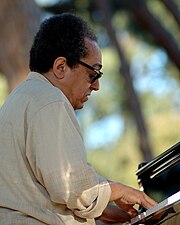Design
Design
Personality
Chart Properties
Your Cross represents the specific theme of your life. This cross embodies your unique potential & the lessons you're here to learn, providing a roadmap to fulfilling your life purpose.
We use the UTC birth time and date to do the calculations required to generate your Human Design chart.
Buy Tokens
Pay as you use, no expiry and no subscription required.Prompt Ideas
Get inspired with some epic prompt ideas.Ben Webster's Biography
American jazz tenor saxophonist, a.k.a. “The Brute” or “Frog.”
Webster was considered one of the three most important “swing tenors” along with Coleman Hawkins and Lester Young. Known affectionately as “The Brute”, he had a tough, raspy, and brutal tone on stomps (with his own distinctive growls), yet on ballads he played with warmth and sentiment. Stylistically he was indebted to alto star Johnny Hodges, who, he said, taught him to play his instrument.
Webster spent time with quite a few orchestras in the 1930s, including Andy Kirk, the Fletcher Henderson Orchestra in 1934, then Benny Carter, Willie Bryant, Cab Calloway, and the short-lived Teddy Wilson big band.
Playing with Duke Ellington’s orchestra for the first time in 1935, by 1940 Ben Webster had become its first major tenor soloist. He credited Johnny Hodges, Ellington’s alto soloist, as a major influence on his playing. During the next three years he was on many famous recordings, including “Cotton Tail” and “All Too Soon”; his contribution (together with that of bassist Jimmy Blanton) was so important that Ellington’s orchestra during that period is known as the Blanton–Webster band. Webster left the band in 1943 after an angry altercation, during which he allegedly cut up one of Ellington’s suits.
In 1953 he recorded King of the Tenors with pianist Oscar Peterson, who would be an important collaborator for Webster throughout the decade. Coleman Hawkins Encounters Ben Webster with fellow tenor saxophonist Coleman Hawkins was recorded on December 16, 1957 along with Peterson, Herb Ellis (guitar), Ray Brown (bass), and Alvin Stoller (drums). The Hawkins and Webster recording is a jazz classic, the coming together of two giants of the tenor saxophone, who had first met back in Kansas City.
Webster generally worked steadily but in 1964 he moved permanently to join other American jazz musicians in Europe, where he played when he pleased during his last decade. He lived in London for one year, followed by four years in Amsterdam and made his last home in Copenhagen in 1969.
Webster suffered a cerebral hemorrhage in Amsterdam, North Holland, in September 1973, following a performance at the Twee Spieghels in Leiden, and died on the 20th.
Link to Wikipedia biography
Your Cross represents the specific theme of your life. This cross embodies your unique potential & the lessons you're here to learn, providing a roadmap to fulfilling your life purpose.
We use the UTC birth time and date to do the calculations required to generate your Human Design chart.
Prompt Ideas
Get inspired with some epic prompt ideas.Adolf Schmidtmann
6/2 Emotional - Solar Plexus Generator

Alain Jean-Marie
5/1 Emotional - Solar Plexus Manifesting GeneratorJasper Bloomberg
6/2 Sacral Generator

Eberhard von Schmettow
2/5 Emotional - Solar Plexus Manifesting Generator

Grand Princess of Tuscany Violante Beatrice
2/4 Emotional - Solar Plexus Projector





